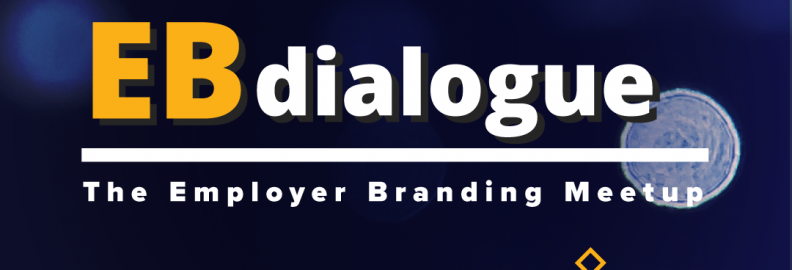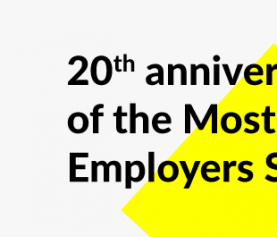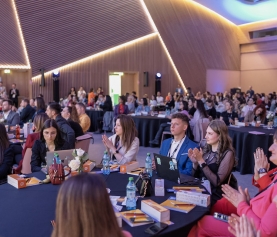December 5th, 2022
On Thursday, November 17th 2022, in our monthly EB Dialogue, we had the chance to speak to Ana Pohrib, HR Manager at Amber Studio Romania, an independent game development & studio services agency based in Romania, Bucharest and Botosani, and with offices in multiple countries around the globe.
Such an insightful discussion it was! We thank the 50 employer branding practitioners joining and we are happy we sparked a fruitful conversation. Especially as it ended with an invitation from Ana to host one of our EBDialogues physically in the Amber HQ in Bucharest!
We’ll take her up on it but until then, if you couldn’t join us last on November 17th, we’ve made a short summary of the (mostly) do’s that came out of the conversation. We concluded that every do can be transformed into a don’t so we’ve decided to keep the talk constructive and focus on what we can and should do, rather than the opposite.
Have a lovely Christmas break (yes, it’s already that time of the year!) and see you again in January, to speak about employer branding ambassadors & ambassadorship programs, but before then, here are the key points from our last talk. The content is linked below:
- Experts and their expertise
- Use a mix of online and offline channels
- Events: from offline to online to hybrid
- Brand ambassadors
1. Experts and their expertise

Back in the day we might have made more use of our professional networks to spread information about companies as employers. We mostly used our own social media channels and we participated in offline events. A lot of them. But nowadays, the social media and the whole online landscape has diversified to such a great extent that it can become overwhelming to communicate about your employer brand online. And then we had the 2 years of pandemics when we couldn’t participate in physical events. The truth is, we as practitioners, may know everything about the process but we may not have the expertise to conquer the new digital communication landscape.
So, hire experts! Hire the people who can tell you that you’re wrong if you want to have 3 posts a day or if you want to have a press release in, say, Ziarul Financiar* (Romanian finance & business newspaper mostly read by more senior professionals) about a junior role.
Create internal roles for employer branding because internal people stay in constant contact with the business, with the cultural organization and may have efficient (and authentic) recommendations. These roles will need power of decision and budget, is true, for them to be efficient. Ana shared that in Amber Studios such roles exist and they fall under the Marketing department. Because they are an independent studio, they can take such organizational decision quicker compared to other companies. However, she did stress the need to have a working triangle between HR, marketing and leadership.
2. Use a mix of online and offline channels

Getting used to communicate almost exclusively online in the past 2 years made some of us somewhat reluctant in reincluding offline channels back into our communication strategies. But, remember, in communicating our employer brands, each channel brings its own value. We sometimes tend to want to use the best channel, but this means we are missing out on the value that other channels bring. Digital channels can be very accurate and targeted with some of them having a very wide reach, but offline events give you that more personal, human, face-to-face feeling.
Do experiment. Don’t start with a certain bias, try out multiple channels, some of them could be new to your strategy. “We’re working with a partner on a project attracting Gen Z and we see they’re changing their behavior. We recommend you spare a small part of your budget to test all sorts of channels and see which ones fit best the profile you want to attract”, shared Dragos Gheban, Managing Partner of Catalyst Solutions. Moreover, don’t forget about the traditional channels.
Multi-channel. Ana shared with us from her experience, saying that at Amber they use various channels (i.e. job boards, career site, digital campaigns, LinkedIn, internal referral programs etc.) and each of them generate a pipeline. Do use digital campaigns. However, they may work better for more junior positions. If you need to recruit more senior staff, direct contact, using your network and the network of your network works much better, in Ana’s experience.
On the other hand, LinkedIn is a good source, but it is expensive. There is concern in the industry that organizations become too dependent on it and that it offers very little space for differentiation which may create a risk for losing competitivity. Either way, the hard work is to generate applicants – even on LinkedIn. Don’t write too long messages, no one will read them.
3. Events: from offline to online to hybrid

The new challenge is how to organize engaging hybrid events – especially for those joining online. When events are large, some organizations chose to do it on location and have it broadcasted to the online audience. Ana shared with us these 3 useful do’s for more engaging online events:
- Have a strong topic, important to the community/audience
- Keep it as short as possible
- Respond to questions
In addition, from our experience, use break out rooms after your speakers. This helps keep your audience engaged, at least the ones who choose to stay. The ones who decided to leave, will leave anyways.
Interaction. The pandemics forced us to give webinars and most of our teaching content across the web – which was beneficial in many ways because you could have people in different parts of the world sharing knowledge. This meant more people reached, more content shared. But now, after the pandemic, Amber Studios started organizing workshops for young professionals which are held by a group of mentors in Amber – senior professionals who also like to teach their profession to others. They organize these directly in universities, and found out that interaction is still higher in face-to-face settings.
Another idea put forward and definitely a do (thank you, Crina Fratean!): invite speakers who are validated by your audience/community. Especially the younger generation is less likely to stay and consume content from someone they have not validated and who comes to “preach” their content.
Combine internal and external knowledge sharing events. When we say employer branding, we’re talking about both internal and external employer branding. Following up on Ana’s idea of webinars or workshops delivered by employees to external groups of young professionals (and hopefully “wanna be employees”), you can consider combining such events to include your more junior employees who may be interested in the subject and even more senior professionals who could be interested in developing adjacent skills and grow horizontally in the company.
4. Brand ambassadors

We really liked the way Ana put it: “employees are the most valuable resource for doing employer branding. This is because either in professional moments or in their personal time, people from the organization will talk about the organization. If they are enjoying the role, the project, the manager, the benefits – anything – they will let the world know. If not, they will do it just as much. Everyone in the organization, including us, HR & marketing people, are ambassadors of our organizations”.
Further on, Ana said they try to keep the ambassadors active and engaged by organizing regular trainings – train the trainer-, by creating a community for these trainers which meets regularly. The way she finds it working is that senior experts, who really know their profession and really like it, feel a great sense of reward when are given the opportunity to share their knowledge with youngsters. So, this is what Amber did – they created partnerships with universities and even high schools.
And then it snowballed – when initial trainers started posting on their own social media channels about the places they’ve been and the things they’ve thought, other colleagues in the organization came forward to say they have topics and would like to train youngsters on them, too.
For our final DO: do get management buy in for your ambassadorship program, for it to be sustainable on the longer term. Ana shared that the main challenge was not to get and keep the mentors engaged, but rather to get buy in from leadership and convince their managers to create space on projects for these employees to be able to invest time in such events. “Because you cannot expect to ask someone to do overtime and then go and be happy when talking about your company. Maybe one time it will work, but this is not sustainable”, said Ana.
Gain access to valuable insights as well as quality interactions with employer branding professionals on September 14th, at our next employer branding meetup – EBDialogue!
- We challenge your perspectives on the following pages:
- Why is your company’s presence in events so essential to strengthen your employer brand?
- What results do events bring in terms of conversion mechanisms?
- How can you maximize leads through quality interaction with the audience?
- What activations can you use during events to best highlight your company’s values?









